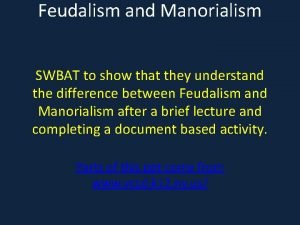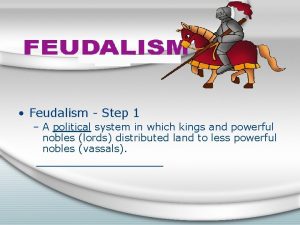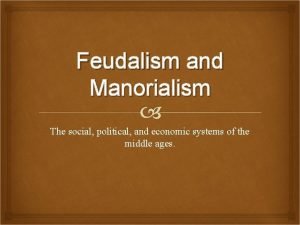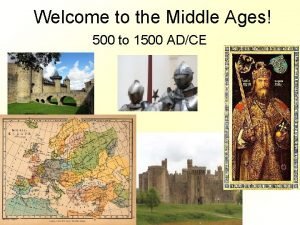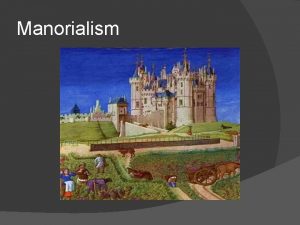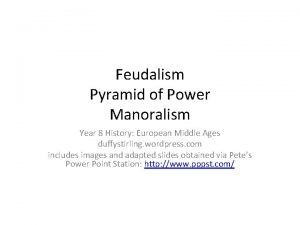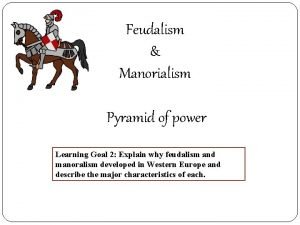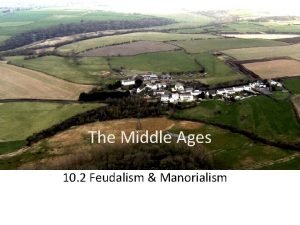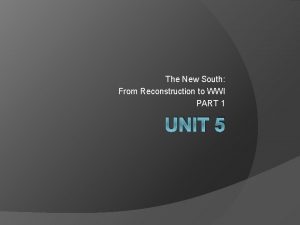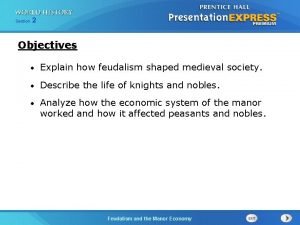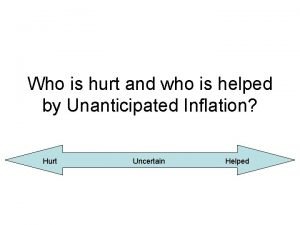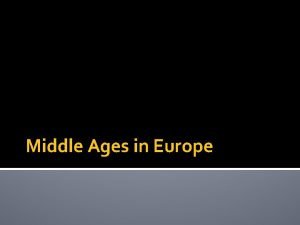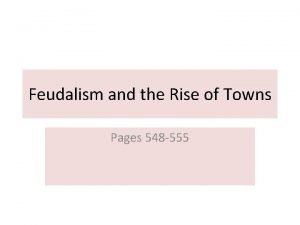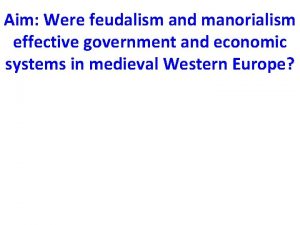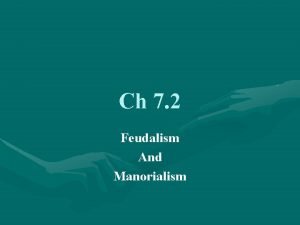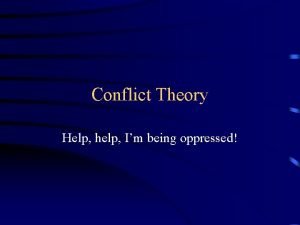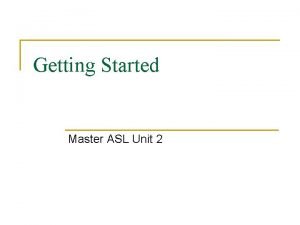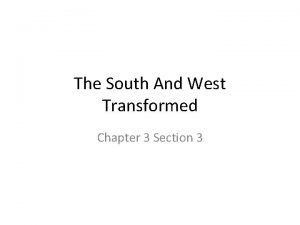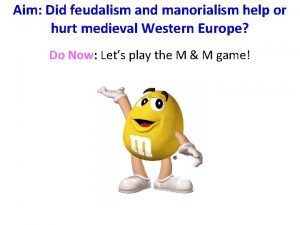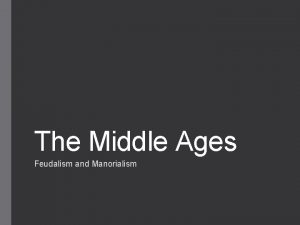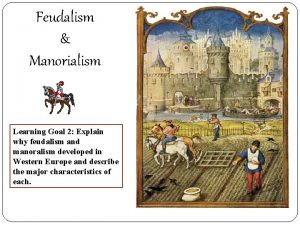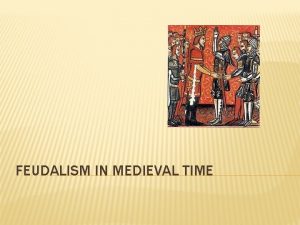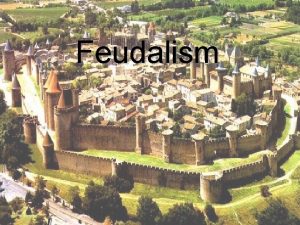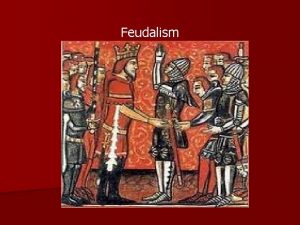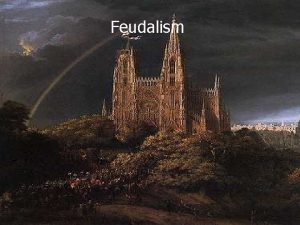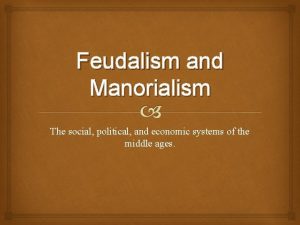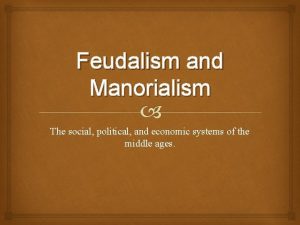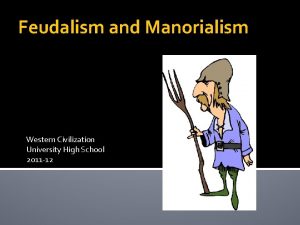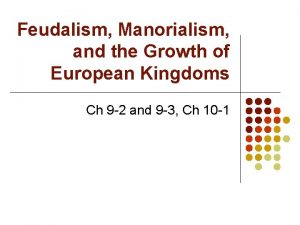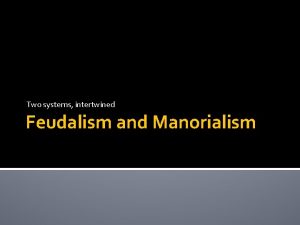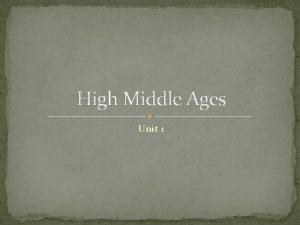Aim Did feudalism and manorialism help or hurt
































- Slides: 32

Aim: Did feudalism and manorialism help or hurt medieval Western Europe? Do Now: Let’s play the M & M game!

I What was feudalism? A) Feudalism was small, localized government based on a system of reciprocity (exchange). A king or lord would allow a vassal to live on his land in exchange for loyalty and protection. The vassal gave an oath of fidelity in order to receive his land. B) Feudalism offered people protection during the Middle Ages. Recall that the Holy Roman Empire tried to reestablish a strong, centralized government in Europe. What happened to the empire? A vassal was anyone who owed allegiance to a lord or king.

FEUDALISM PYRAMID Land is given KING Protection is given LORDS KNIGHTS SERFS Serfs were peasants who were given protection by their lord, but were bound to the land. 3

Oath of Fidelity I: An Anglo Saxon Form of Commendation [from Schmidt: Gesetze der Angelsachsen, p. 404] Thus shall one take the oath of fidelity: By… [God] before whom this sanctuary is holy, I will to… [my Lord] be true and faithful, and love all which he loves and shun all which he shuns, according to the laws of God and the order of the world. Nor will I ever… do anything which is unpleasing to him… and that he will perform everything as it was in our agreement when I submitted myself to him and chose his will. According to this oath of fidelity, what is the vassal supposed to do for his lord? What is the lord supposed to do for his vassal?

II Feudal Justice A) Most kings & lords did not follow a law code. B) Justice was carried out in the lord’s manor house. This often included trials by ordeal: TRIALS BY ORDEAL: 1. The accused had to carry a burning hot iron rod. If you developed blisters you were guilty. 2. The accused plunged their hand into boiling water. If you developed blisters you were guilty. 3. The accused was thrown into water. If you floated you were guilty. 4. The accused would battle his accuser. The loser was found guilty. *It was believed that God would prove innocence and guilt through these “trials”.

1. Trials by Water and Fire Which was worse? ? Were either of these justice?

Trial by Ordeal and Trial by Battle

III Medieval Knights A) Medieval knights were mounted soldiers, and were vassals to their feudal superiors (a lord or king). B) Medieval knights went through extensive training. 1. At the age of 7 a boy could become a page. He left his family for his lord’s castle to begin his training. - Combat and weapons skills - How to ride a horse in battle 2. At the age of 15 a page could become a squire. You were assigned to a knight to continue training. 3. Once you proved yourself in battle you became a knight in an elaborate ceremony. This is a medieval battle axe. It was curved to enable the user to knock a knight off of his horse, and it was sharp enough to chop off limbs. Medieval weapons were made by blacksmiths.

C) In the early Middle Ages, knights wore chain armor made of 1000 s of interlocking metal rings. By the High Middle Ages, new weapons were invented (such as the longbow), and chain armor became replaced by plate armor. Plate armor was more difficult to penetrate, but it was much heavier. If a knight fell off his horse, it was very difficult to get back up. Also, plate armor was not very effective against gunpowder. D) When not in battle, knights would joust in tournaments (mock battles). *Injuries and death were not unusual!

IV Chivalry in the Middle Ages A) By the High Middle Ages, knights were following a code of chivalry. 1. Bravery in battle 2. Loyalty to your lord 3. Defend the church and the helpless 4. Protect women and treat them with courtesy Chivalry became the basis of modern Western manners. Some say chivalry is dead. Is that true? If yes, should we bring it back?

Chivalry in the Middle Ages Continued… B) In the Middle Ages marriage was often arranged, and was not usually based on love. This led to the idea of courtly love; the love a knight held for a lady whom he was forbidden to be with. (Either because he was below her social status, or she was already married to his lord!) Such love was unrequited (unobtainable) in this life.

Heloise and Abelard: A Tale of Unrequited Love Both Abelard and Heloise lived in 12 th century France. Abelard, of noble birth and 18 years the senior of Heloise, was a respected teacher of philosophy. Heloise was a well educated [especially for the time] woman who was fluent in Latin, Greek and Hebrew, and came from a lower social standing than Abelard. At age 19, and living under her uncle‘s roof, Heloise fell in love with Abelard, who she was studying under. Not only did they have an affair, but they had a child out of wedlock. Discovered by her uncle, Abelard was assaulted and castrated by a hired thug, and Heloise was forced to enter a convent to become a nun. Abelard was exiled to Brittany, where he lived as monk. They only saw each other in person once more, but they wrote letters of longing for many years. “…We may write to each other; so innocent a pleasure is not denied us. Let us not lose through negligence the only happiness which is left us, and the only one perhaps which the malice of our enemies can never ravish from us. I shall read that you are my husband you shall see me sign myself your wife. . . I shall read your most sacred thoughts; I shall carry them always about with me, I shall kiss them every moment…”

V Life in a Castle A) In the early Middle Ages, most Lords lived in a simple manor house made of wood. B) By the High Middle Ages, some Lords lived in stone castles that served as a home and a fortress. C) Medieval life in a castle was harsh by modern standards, but much better than life for the majority of people at the time. Castles had basic lavatories called garderobes (the waste would end up in the moat). Light was provided by candles or oil lamps. Fires were placed in the centre of the Great Hall, until the later middle ages with the invention of the chimney. Large medieval castles were generally divided into apartments so that each noble individual (including children) would have their own suite of rooms and their own household staff. When the lord had obligations that took him away from the castle his main representative was the steward. Other key members of the household staff included the chamberlain (in charge of the great chamber/hall), the chaplain, the keeper of the wardrobe, the butler (also known as the bottler, he ensured there was enough drink stored in the buttery, where the butts of drink were stored), the cook, the chandler (who made candles), and the marshal (who was in charge of the stables). Each of these individuals had their own, often large, staff to manage. The lady of the castle was served by ladies-in-waiting and chambermaids. She spent much of the day overseeing their work, as well as supervising the activities in the kitchen staff.

Life in a Castle Continued… Soldiers were needed to provide a castle garrison. They were stationed in gatehouses and guardrooms. Individual members included the knights, squires, a porter (to tend the main door), guards, watchmen, and men-at-arms. They might need to defend their lord and his household in an instant. Each soldier had his own place in an attack and his own skill to rely upon. Some were crossbowmen, archers, lancers or swordsmen. If the battle started and the lord was not at home, the lady organized the army. A siege was an army strategy; the attacking army surrounded the castle to stop supplies from coming to the castle. Usually a siege only lasted a few weeks, but could last months or even years. Castles were noisy and smelly! Livestock roamed inside the stables, blacksmiths banged out ironwork in castle forges, soldiers practiced their skills, and children played when lessons were completed. Leftover food was often thrown to the dogs, the floor, or the moat.

Life in a Castle Continued… Feasting and enjoying food was an important part of medieval life, because during a war there wasn't very much to eat. Nobles had to pay for food and wages for his household. Bread was the basic food in the Middle Ages, it could be made with barley, rye, or wheat. Only the wealthy could afford bread made from finely ground grains. [Guess what The medieval pasty is the happened to most peoples teeth from eating origin of our modern pie! course bread ground with stones] Wealthy Originally the crust wasn’t people used thick slices of brown bread as eaten but kept the filling from spoiling (it often bowls called trenchers as plates. They used knives but ate with their fingers. (But they did contained meat), and it could be eaten by hand “on dip their fingers in water bowls!) Medieval the go”. food often used numerous spices to cover up the taste of spoiled meat.

Keep Outer Gatehouse Inner Gate Moat


Ross Castle, Killarney, Ireland

Castle Of Counts, Ghent, Belgium

Bottle Dungeon, Saint Andrew’s Castle, Great Britain

VI What was the Manor System (Manorialism)? A) Manorialism was an economic system in western medieval Europe. It was intertwined with the government system of feudalism. B) Manorialism was based on the manor (large farming estate). The manor was mostly self sufficient; almost everything needed for survival could be made on the manor. The manor had: 1. A manor house or castle where the Lord lived 2. Plots for farming 3. Woods (for hunting) 4. Church 5. Mill to grind grain(usually by a stream) 6. Village for serfs (peasants bound to the land by debt)


Manor House, Dorset, England 1355

Water Mill The force of the water moves the wheel, which moves a grindstone to grind grain into flour. A donkey attached to a grindstone was equal to 15 men, but a water mill was equal to the power of 30 – 60 men!

The Medieval Manor Continued… C) The lord kept 1/3 of the land (domain) for himself. Serfs had to farm the lord’s domain, turn over crops from their own fields and do any other services the lord asked. D) Serfs could not leave the manor or hunt without permission.

Manorialism Continued… E) Serfs used crop rotation; the farm land was divided into two fields. This was known as the 2 field system. One field would be planted and one left fallow (unplanted) to regain its fertility. By the High Middle Ages, some farms had 3 or more fields. This was known as the 3 field system.

VII Exceptions to Manorialism A) There was limited trade existed in Western Europe before the High Middle Ages. B) Trade was more common in Southern Europe; Venice created an empire based on trade with the Byzantine Empire and the Arab Middle East. C) As a result of the Crusades, trade increased dramatically.

VIII Manorialism in Tonga A) “In terms of the traditional social and political organization, all land in Tonga belonged to the King… there were chiefs who were “lords of large districts of territory” and who held their lands from the king in return for taxes and military service. These “principal barons” sublet their holdings to their lesser kinsmen and followers, and everyone held land from his superior in a pattern similar to that between the king himself and his barons. ” The Journal of the Polynesian Society B) Today all the land in Tonga belongs to the Tongan Crown; but the traditional holdings of the “barons” are now classified into Royal Estates… Each estate may run into a thousand or more acres; each member of the Royalty as well as of the nobility may hold several of them in different parts of the kingdom. From them, allotments are granted to individual Tongans. . . – The Journal of the Polynesian Society Volume 68 1959 > Volume 68, No. 2 > Land tenure and social organization in Tonga, by R. R. Nayacakalou, p 92 -114

Manorialism in Tonga Continued… Tongan Palace Tongan Slums Tonga's King George Tupou V, 63, died in March, 2012.

Family Crest Used to identify knights and nobility. Notice the lack of writing!

Focus Questions 1. Fill in medieval western Europe on your period 3 chart. *Only include the most important points as we will be in the middle ages for a bit more time 2. Describe the systems of feudalism and manorialism. Do you think they were effective and/or made sense for the time? 3. Describe life in a castle. How did this compare to life for the patricians in ancient Rome? Is it similar to castle life as depicted in fairy tales? 4. Describe feudal justice. How is this similar or different from justice in ancient Rome or the Byzantine Empire? Do you think it was just? If not, why do you think this system was used? 5. What happened to Heloise and Abelard? Is this story romantic? What does it tell us about medieval culture in western Europe? 6. How do you know that Tonga even in the 20 th century had a feudal system? How do you feel about this?

Key Vocabulary ü ü ü ü 2 field system 3 field system Blacksmith Castle Chain Armor Chivalry Courtly love Domain Eloise and Abelard Fallow Feudal Justice Feudalism Joust Knight Lord Manor ü ü ü ü Manorialism Oath of Fidelity Page Plate Armor Reciprocity Serf Song of Roland Squire Tonga Tournament Trial by Ordeal Unrequited love Vassal Water mill
 Feudalism
Feudalism Feudalism and manorialism venn diagram
Feudalism and manorialism venn diagram Manorialism
Manorialism Feudalism and manorialism venn diagram
Feudalism and manorialism venn diagram What is manorialism
What is manorialism Pyramid of power in middle ages
Pyramid of power in middle ages Feudalism pyramid of power
Feudalism pyramid of power Manorialism def
Manorialism def Lugenia burns hope
Lugenia burns hope Help ever hurt never
Help ever hurt never Deadly venoms help rather than hurt
Deadly venoms help rather than hurt How did feudalism shape medieval society
How did feudalism shape medieval society How did feudalism organize society
How did feudalism organize society Education through self help is our motto
Education through self help is our motto Who is hurt and who is helped by unanticipated inflation
Who is hurt and who is helped by unanticipated inflation Manor system def
Manor system def Manorialism
Manorialism Manorialism acrostic poem
Manorialism acrostic poem Define manorialism
Define manorialism Nomad definition world history
Nomad definition world history Manorialism nedir
Manorialism nedir Manorialism synonym
Manorialism synonym Freesurfer troubleshooting
Freesurfer troubleshooting Help im being oppressed
Help im being oppressed Becoming a helper 7th edition
Becoming a helper 7th edition Help us help you
Help us help you N
N What they don't know wont hurt them
What they don't know wont hurt them These are often a pronoun of a destructive home environment
These are often a pronoun of a destructive home environment Hurt level
Hurt level The hurt locker 2008
The hurt locker 2008 What three circumstances hurt native american
What three circumstances hurt native american “has technology helped or hurt society”.
“has technology helped or hurt society”.
